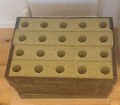Edible wall
This page is under construction!
Objectives and context
Motivation: upgrading a multi-functional “living wall”
Our general motivation is to produce food on-site, while valorising excreta (human waste) and combining several advantages. In this project, our mission is to upgrade existing “living walls” to combine several functions and characteristics:
- Grow edible plants (or medicinal, scented… instead of just decorative exotic plants)
- Fertilise the plants with human source-separated urine only (and avoid using any chemical fertiliser)
- Purify indoor air, which passes through the soil and root system
- Use material that is renewable, locally available, … (as much as possible)
- Have a beautiful planted wall, that increases well-being in offices, inside buildings, or in the city
Among these functions, we want to focus in priority on valorising human urine to grow edible plants. Yerk?! Yes, you read it correctly. And you should get convinced of the many advantages of the reuse of urine for agriculture by reading a coming page…
System description and constraints
Soil substitute
The vertical “modules” consists of panels of a kind of compressed roock wool: Grodan (although we might change this in the future if we find another renewable material with the same properties). The plants are planted in holes, and their roots then develop through this 'matrix' and at the back of the panels. Specificity: very little real natural soil, lightweight.
Fertigation (= irrigation + fertilisation)
Drip irrigation, with a nutritive solution made of tap water and currently a chemical fertiliser, which we’ll replace by urine. Similarly to a hydroponic system, the solution must contain all nutrients needed by the plants, in a readily available form, and in the appropriate concentration for continuous fertigation (as opposed to punctual fertilisation).
This means that the nutrients concentration shouldn’t be too high, because 1. Too high an ammonium concentration is toxic to plant [refs] 2. Excessive fertilisation also causes damages, such as nitrates accumulating in leaves [refs].
Plants for vertical indoor garden
[…]
Urine collection & storage
See the page DIY waterless urinals (This may serve also to other projects!)
Nitrifiying solution
Wall structure and irrigation system
Test the nitrification in modules – experiment
